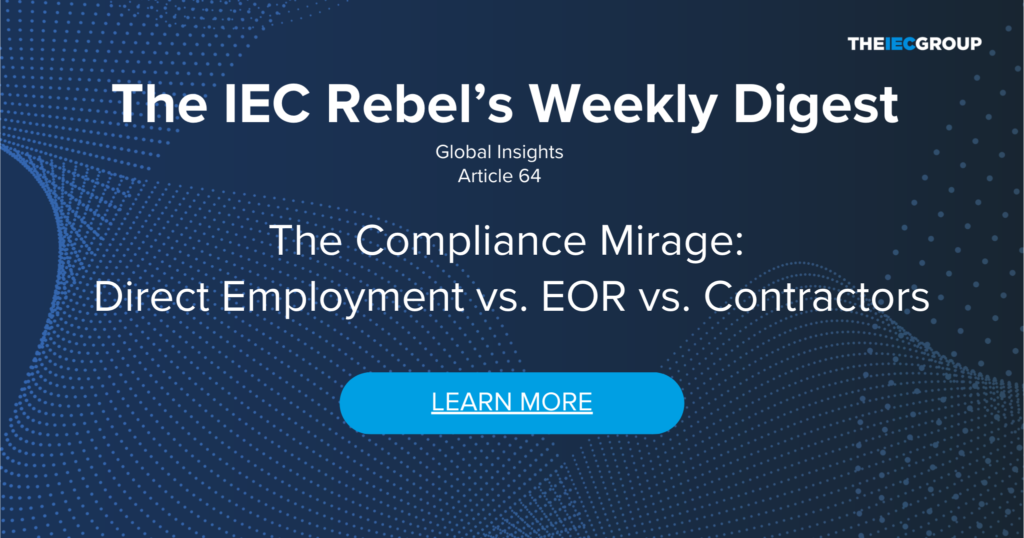The Compliance Mirage: Direct Employment vs. EOR vs. Contractors
Welcome What 100% Compliance Really Means – And Why You Probably Aren’t There
 Let’s get one thing straight: compliance isn’t a badge you wear, it’s a moving target you chase—blindfolded, while riding a unicycle through a global legal minefield.
Let’s get one thing straight: compliance isn’t a badge you wear, it’s a moving target you chase—blindfolded, while riding a unicycle through a global legal minefield.
Whether you’re hiring direct employees, contractors, or dancing the EOR (Employer of Record) tango, there are traps, shortcomings, and unspoken truths that can gut your global people strategy faster than you can say “statutory benefits.”
Direct Employment: The Siren Song of Control
Going direct sounds powerful. You hire. You onboard. You own the relationship.
Until you don’t.
Challenges:
- Local Entity Requirements: You need a legal entity in-country, full stop. Think taxes, payroll infrastructure, labor law expertise, and local counsel on speed dial.
- Misclassification Risk: Try hiring a contractor when you really want a full-time employee. Courts don’t care what your contract says—they care about behavior.
- Termination Traps: In many countries, at-will is a myth. Severance can bankrupt a startup. Local labor boards have teeth—and they bite hard.
Shortcomings:
- Operational Drag: Setting up a legal entity can take months, not to mention the administrative overhead and ongoing filings.
- Hidden Cost Center: Compliance, payroll, HR, benefits administration—these don’t scale cleanly.
The Trap:
Believing you’re compliant just because you followed the letter of the law.
Spoiler: the spirit of the law is what regulators—and judges—enforce.
EOR: The Outsourced Shield (With Cracks)
Enter the EOR. They say, “You don’t need an entity. We’ll hire them on your behalf. Easy.”
Sounds like magic. Often, it almost is.
Challenges:
- No One-Size-Fits-All: Not all EORs are created equal. Some are just SaaS with a smile, others are Frankenstein webs of third-party partners.
- Limited Control: Want to fire someone in France because they ghosted Slack? Your EOR will politely decline—and rightly so. You’re a shadow employer, but not the employer.
Shortcomings:
- Blurry Employer Brand: Employees often don’t know who their real employer is—EOR or client? That can hurt culture and retention.
- Cost Premiums: You pay for simplicity. But margins can be steep, especially at scale.
The Trap:
Assuming the EOR absorbs all the compliance risk. Many contracts are structured to push liability right back to you if something goes wrong.
Contractors: The Freestyle Gamble
Quick, flexible, often global. But let’s not sugarcoat it—contractors are the compliance wild west.
Challenges:
- Classification Risk: If they act like employees, clock like employees, and take direction like employees… congratulations, you’ve misclassified them.
- Tax and IP Nightmares: Ever try enforcing IP transfer clauses in Vietnam or tax compliance in Colombia? Good luck without local legal muscle.
Shortcomings:
- No Safety Net: No benefits, no security, no obligation—until a regulator or disgruntled contractor disagrees.
- Ghosting & Liability: Contractors disappear, or worse, file retroactive claims for benefits or misclassification damages.
The Trap:
Using contractors as a cheap EOR alternative. You save upfront and pay later—with interest and a court date.
Scene IV: The Contractor-EOR Mashup – The Legal Bermuda Triangle
On paper, it looks tidy.
You want flexibility, no entity, and less risk. The EOR says,
“Sure, we’ll engage your contractors on your behalf.”
Sounds perfect, right?
Wrong.
This hybrid model combines all the complexity of contractor classification with the operational ambiguity of outsourced employment. Spoiler: You don’t escape risk—you just reroute it through someone else’s infrastructure.
The Illusion: EOR = Safety Net for Contractors
Many EORs will engage contractors as independent workers under their name.
You think this means:
- No misclassification risk
- Someone else handles tax forms
- You’re free and clear
But what it often actually means:
- You’re still functionally the employer (direction, deliverables, hours)
- The EOR just acts as a payment processor or “proxy payer”
- If a regulator comes knocking, you’re still in the spotlight
The Core Issues:
- Classification Risk Still Applies:
The EOR isn’t waving a legal wand here. If your “contractor” behaves like an employee—guess who’s liable?
You. Not the EOR.
Many EOR contracts explicitly state that you’re responsible for accurate classification.
- Dual-Blindness:
Contractors believe the EOR is their employer.
You think the EOR owns the compliance.
Reality: No one’s truly in charge.
This can lead to:
- IP ownership gaps
- Disputes over termination or deliverables
- Total chaos in jurisdictions with strict contractor definitions (hello, Germany, Brazil, Spain…)
- Local Law Doesn’t Care About Your Paper Trail:
You can have the neatest contractor agreement on earth—signed through an EOR, reviewed by your cousin’s lawyer—but if it smells like employment, the local labor authority will treat it as such.
Why Some Companies Still Do It
Because it can be useful for:
- Paying contractors in countries with currency restrictions
- Getting tax documents filed without setting up an entity
- Engaging digital nomads without violating local tax laws
But that’s operational convenience, not compliance immunity.
What Does 100% Compliance Really Mean?
Let’s kill the myth: 100% compliance is a moving target defined by risk appetite, jurisdiction, and enforcement reality.
It means:
- You know the rules—and where they’re fuzzy.
- You have local legal guidance, not just a SaaS dashboard.
- You document, segment, and proactively manage worker classification.
- You acknowledge that compliance is a strategy, not a checkbox.
But most of all:
It means accepting that global hiring is a calculated risk, not a guaranteed win.
What Do We Learn?
The takeaway is crystal clear: Choosing the right EOR is essential.
Global compliance isn’t just about ticking boxes—it’s about partnering with an entity that truly understands and mitigates local risks. That’s why the IEC Group has taken the initiative to assess over 100 global EOR companies. By distilling this landscape into a curated list of the best 25, and highlighting the industry leaders, the IEC Group empowers companies to find the best fit based on their individual needs and risk profiles.
This rigorous evaluation ensures that you:
- Avoid the pitfalls of misclassification and hidden liabilities.
- Gain clarity on which EOR partners can genuinely shoulder compliance risks.
- Make informed decisions that align with your company’s global expansion strategy.
Rebel’s Verdict:
If you’re going global, you’ve got three paths:
- Direct employment – if you want full control and long-term presence, pay the price (and the lawyers).
- EOR – if speed and simplicity matter more than owning the process. Just read the fine print—twice.
- Contractors (including those managed via EOR) – if you truly need flexible labor and have the legal frameworks to back it up. Otherwise? Proceed at your own peril.
No path is perfect.
But only one thing is worse than a messy global compliance setup: pretending you don’t need one.
Until next time, —hire globally, but carry a big legal stick.
– The IEC Rebel’s Digest Team
Next issue: Why “hire first, figure it out later” is the most expensive HR policy you never budgeted for.
For expert guidance on choosing the right EOR partner, reach out to the IEC Group—your strategic ally in navigating global compliance.
Go To’s: After rading this article you should
✅ Audit your global workforce setup.
✅ Review your EOR or contractor arrangements.
✅ Get legal clarity on misclassification risks.
✅ Use IEC’s Top 25 EOR list to find your fit.
IEC Rebel’s Digest—Navigating the complexities of global enterprise with clarity and insight.
Last but not Least: If you’re facing challenges and wondering how others are managing similar issues, why not join The Leadership Collective Community? It’s a peer group and webcast platform designed for leaders to exchange insights and experiences.
Introducing the IEC Knowledge Network Free Membership – Your Gateway to Seamless Access!
We are thrilled to present a new service that goes beyond the ordinary download experience. In addition to offering you the ability to download the things you love, we are delighted to introduce the IEC Knowledge Network Free Membership.
The Free Membership option grants you access to our library of articles and videos, without the need for tedious registrations for each piece of content.
The publication serves as a trusted resource to support executives in their pursuit of sustainable and successful global expansion. In addition the IEC Practitioners are available to discuss your specific challenge in more detail and to give you clear advise..
Take advantage of this valuable resource to accelerate your global expansion journey


